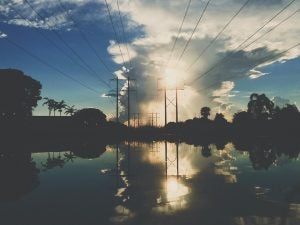If we don’t talk about water, are we really talking about resiliency?
 It’s time to rely on water-smart power
It’s time to rely on water-smart power
Energy Secretary Rick Perry is trying to prop up coal and nuclear companies under the guise of enhanced “resiliency.” The Department of Energy’s (DOE) proposal does not define resiliency, nor does it even make clear what resiliency means in the context of the electric grid.
Resiliency in the energy sector generally, however, depends on water. The majority of the electricity that powers our world runs on century-old technology, guzzling down our most precious resource: water. Depending on the type of technology, generating just one megawatt-hour of electricity could use anywhere from 500 to 50,000 gallons. Solar and wind, on the other hand, use negligible amounts of water, and energy efficiency uses none.
Yet neither the DOE’s proposal nor its recent study on grid reliability touches on climate and water. Specifically, there is no mention of how climate change affects water availability or what that means for electric reliability. If Secretary Perry is really concerned about resiliency, water should be a key focus. And as a former governor from a drought-stricken state, he should know better.
[Tweet “If we don’t talk about water, are we really talking about resiliency?”]
Thirsty energy and a changing climate
Eighty-five percent of U.S. electricity is generated by incredibly thirsty resources: fossil fuel and nuclear power plants. As a result, the country’s power sector withdraws more water than any other sector of the economy. In 2010 (the most recent data year), the power sector withdrew 161 billion gallons of water per day, accounting for about half of all freshwater withdrawals in the country (“withdrawal” is the amount of water taken from the water source, whereas consumption is the portion of that water used and not returned to the original source for reuse).
That’s why if we’re talking about reliability, water availability has to be part of the conversation.
In 2010 (the most recent data year), the power sector withdrew 161 billion gallons of water per day, accounting for about half of all freshwater withdrawals in the country.
Secretary Perry, of all people, should understand this. He was the Governor of Texas for 14 years, during which time the state suffered through one of the worst droughts in its history. The Electric Reliability Council of Texas (ERCOT), which manages the electricity of nearly 90 percent of the state, frequently ran into reliability issues related to heat and drought during the driest years. Curtailment – or restricting power – and brownouts were regular topics of conversation.
Why? When it’s hot and dry, people turn their air conditioners up, which increases overall electric demand. When demand increases, more power is needed, tapping into more and more of the decreasing supplies of water. It’s a vicious cycle, and water is at the heart of it.
Add in climate predictions, and we’re looking at hotter and drier as the new norm for much of the country. The effects won’t just be in places like Texas and the West – recently, New England and the Southeast suffered unprecedented droughts.
Although most places have been able to avoid power shutdowns so far, recent years have seen curtailment and stress, especially on nuclear power (the second thirstiest energy source after coal) in Illinois, Georgia, and South Carolina.
Demanding a water-conscious future
To meet future energy demands and ensure reliable electricity, low-carbon and water-smart energy choices need to be at the forefront of electricity decision-making. Renewable energy is a win-win solution to water scarcity on a warming planet, and a future focused on renewables will cut carbon pollution, while easing the stress climate change puts on water availability.
If the Department of Energy wants resiliency, Secretary Perry should prioritize innovation and research and development – not seek to prop up the thirsty coal and nuclear industries.












One Comment
Kate, once again EDF employs guilt-by-association to link nuclear and coal together, when the first has all the benefits of the second (plentiful fuel, inexpensive, dispatchable) and none of its drawbacks.
Oops – forgot water…yes, let’s talk about water.
As one might expect, an energy source which generates billions of watts of power generates billions of watts of thermal energy – both wasted, and (eventually) that which is used productively. To cool off the equipment making all that energy nuclear (and coal, and natural gas) need a thermal conductor with enough mass to do it quickly. A 2GW nuclear plant with a Once-Through Cooling (OTC) system borrows up to 600 million gallons of water/day, then pays it back to the ocean or another waterway where it’s able to dissipate heat into the environment.
Extensive precautions are taken so that happens with minimal impact on plant and animal life. At Diablo Canyon Power Plant the temperature differential between input/output water is limited to a maximum of 15ºF. When input water is cold it can be less than half that (cold water cools more efficiently). Warmer water near the discharge pipes has had the effect of creating a Southern California ecosystem locally, but beyond 1/4 mile there is no environmental impact whatsoever. And of course, nuclear energy emits no carbon to the air.
Compare that to renewables and gas, their indispensable counterpart for generating a constant supply of energy. When San Onofre Nuclear Generating Station was shut down in 2013, except for a token amount of renewable energy, its output was completely replaced by burning natural gas – adding 9 million tons of CO2 to California’s emissions.
See the difference? The guilt-by-association of renewables with gas is legitimate and verifiable – not the spurious product of irrational fear.